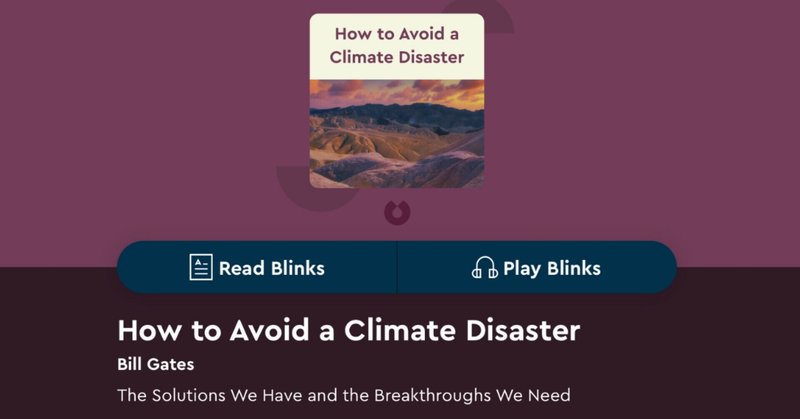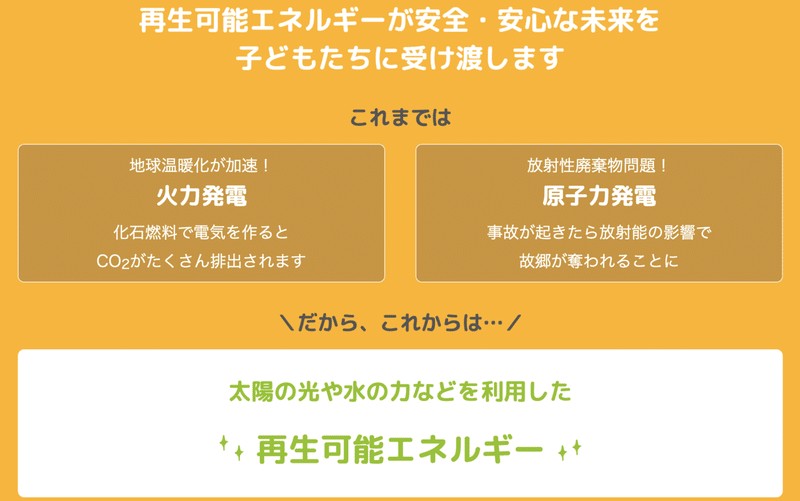
英語学習日記 #19 "How to Avoid a Climate Disaster"
今回学んだアイディア
・気候変動を止めるには、2050年までにゼロエミッションを達成する必要がある
・食糧生産(家畜を育てる、穀物を栽培する)によるCO2の排出量は、車や船、飛行機等の移動・輸送手段による排出量よりも多い
・Green Premiumとは
こんにちは!
こちらの英語学習日記シリーズでは、Blinkistで新しく知った英語表現や英単語を中心に、個人的に面白かった、勉強になったポイントを紹介していきます。今日はその第19回です!
既に20記事ほど投稿していますが、いまだに自己紹介の投稿をしていないことに気付き、毎日の英語学習日記と並行して、少しずつ自己紹介の執筆を進めています。
今日のBlinkについて
本日のBlinkのタイトルと著者はこちら。
How to Avoid a Climate Disaster by Bill Gates
- The Solutions We Have and the Breakthroughs We Need -
あのビル・ゲイツが、2021年2月に出したばかりの、タイムリーな1冊です。
新型コロナウイルスが流行する5年前から、ビルがウイルスによる世界的危機を予測していたこと(下のTED Talksの動画です)にも驚かされましたが、気候変動などの世界規模の問題を解決するために様々な投資をして、世界中の人々の意識改革を起こすためにいくつも本を書いているのは本当に偉大だと感じます。
2050年までにゼロエミッションを達成しなければならない、とビルは言います。そのために知っておくべきこと、個人として・社会としてやるべきことが書かれていたので、今日は多めに紹介するつもりです。
今日のBlinkから得た学び
今日のBlinkの内容で、個人的にためになったものを引用します。
The effect of these greenhouse gases is that the planet has gotten hotter. Since the dawn of the Industrial Age, the average global temperature has risen one degree Celsius; some areas have even experienced a rise of over two degrees. That may not sound like much, but, on a global scale, it is. And there are many far-reaching consequences.
For example, increased temperatures cause more moisture from the earth’s surface to evaporate into the atmosphere. As a result, there are more droughts around the world, more wildfires, and more flooding in areas already in danger of being consumed by water. Already, 20 to 30 percent of Bangladesh is underwater on a regular basis. This problem will only get worse – and more common around the world. This means more displaced people, as well as fewer habitats for both plants and animals.
産業革命以降、地球の平均気温は1℃上昇した(2℃以上上昇した地域もある)。
この急激な気温上昇の原因は、人類が毎年510億トンの温室効果ガスを大気に放出しているから。この数字は下がるどころか毎年上昇し続けている。
気温上昇によって液体として存在する水の量が減り、気体として存在する水の量が増えることで、世界中で干ばつ、山火事、洪水などの災害が増える。
バングラデシュでは、海面上昇により国土の2、3割が頻繁に浸水している。
ここでのgreenhouse gases(温室効果ガス)とは、二酸化炭素、メタン、窒素酸化物などを総称した呼び方です。CO2はそのうちの70%以上を担っているので、より科学的な文脈ではgreenhouse gasesのことをcarbon dioxide equivalentsと呼びます。前述の510億トンは、それらの温室効果ガスをすべて二酸化炭素に換算した場合の質量となります(CO2eと言うようです)。
You might be surprised to learn that, in the US, a gallon of oil currently costs around one dollar, while a gallon of a soft drink is nearly three times that – around $2.85. That’s right, oil is almost three times cheaper than soda!
1ガロンの化石燃料とソフトドリンクを比較すると、ソフトドリンクの方が3倍近くも高い値段で売られている。
これほど安く流通している化石燃料が私たちの文明や暮らしを支えていることは間違いありませんが、化石燃料の燃焼が気候変動に重大な悪影響を与えていることも事実です。今後も世界全体でエネルギー需要は増加する見込みなので、経済的に実行可能な、別のエネルギーの選択肢を広げていかなければなりません。
なお、化石燃料の代わりにクリーンなエネルギーで発電すると、現時点では化石燃料よりも高いコストが発生するのですが、この差額をGreen Premiumと呼ぶそうです。バイオ燃料ではガソリン価格の106%、electrofuel(空気中の二酸化炭素からつくられる液体燃料)では237%のGreen Premiumがかかるそうです。
Currently, the biggest contributors to the climate crisis can be broken down into five categories: Making things, such as steel and plastic, accounts for 31 percent of our 51 billion tons of emissions. Plugging in, or electricity, accounts for 27 percent. Growing things, like plants and animals for food, accounts for 19 percent. Getting around – be it cars, planes, or cargo ships – accounts for 16 percent. And finally, Keeping warm and cool, with regard to both ourselves and our things, accounts for 7 percent.
前述した510億トンの温室効果ガス排出の5大要因は、製造が31%、発電が27%、農畜産物の生産が19%、人や物資の移動が16%、冷暖房が7%。
気候変動の文脈では、車の排気ガスがいつもその主原因として槍玉に挙げられる印象ですが、食糧生産によるCO2の排出量が、車や船、飛行機等の移動・輸送手段による排出量よりも多いって意外ですね!
Electricity is a good place to start because it affects all the other categories. Right now, two-thirds of the world’s electricity is supplied by burning fossil fuels. Getting this ratio down to zero will naturally have a major impact on how we make things, grow things, get around, and so on – things like factories, agriculture, and cars will all require clean electricity to function.
世界で利用されている電力の3分の2は、化石燃料を燃やすことで発電されている。クリーンエネルギーの利用を増やし、この比率をゼロに近づけていくことで、他の4領域(製造、農畜産物生産、輸送、冷暖房)による温室効果ガスの排出も抑えることができる。
And this will only increase as more countries become more prosperous. Between 2000 and 2016, for instance, China used more concrete than the US did during the entire twentieth century.
中国は2000年から2016年の間に、アメリカが20世紀の100年間で使ったよりも多くのコンクリートを使った。
多くの国が発展するほど、鋼鉄・コンクリート・プラスチックなどの、製造工程で多くのエネルギーを要し、多量の温室効果ガスを排出する資源が都市開発に用いられる、という文脈で登場した具体例ですが、衝撃的ですね。
Steel, an alloy of iron and carbon, naturally releases some of that carbon while being made. Also, it needs to be heated to incredibly high temperatures – temperatures that are difficult to create with electricity alone. Right now, heating fossil fuels provides a cheap and easy way to make steel, but it also means that one ton of steel generates 1.8 tons of carbon dioxide.
炭素と鉄の化合物である鉄鋼の製造工程では、化学反応に必要な高温を、化石燃料の燃焼によりまかなっている。1トンの鋼鉄を製造するために、1.8トンの二酸化炭素が排出される。
Concrete production also uses fossil fuels to cheaply and efficiently generate heat and carbon. In particular, cement – a key component of concrete – requires the burning of limestone, which is made up of calcium plus carbon and oxygen. This all adds up to a grim one-to-one ratio: one ton of cement roughly equals one ton of carbon dioxide emissions.
コンクリートの製造においても、炭素と熱を発生させるために化石燃料が使われている。コンクリートの材料となるセメントの製造では石灰岩の燃焼が必要となるが、1トンのセメントを製造するために、約1トンの二酸化炭素が排出される。
Plastics, which may have the worst reputation, may actually come with a silver lining in the future. All plastics contain carbon. In fact, they’re a great place to store carbon. Half of the carbon created when making plastic goes into the plastic itself. And plastic is notoriously bad at decomposing, which means that the carbon won’t be going anywhere for a long time. The problem is, we currently get the carbon for plastic by using fossil fuels, which is why making plastic is cheap. But that doesn’t have to be the case.
プラスチックは微生物によって分解されずに、いつまでも残る性質があるが、これが将来の炭素貯留の鍵になるかもしれない。現時点では化石燃料に含まれる炭素からプラスチックを作っているが、発電所で排出された炭素(二酸化炭素)からプラスチックを作る技術(carbon capture technology、炭素回収貯留技術)がより安価かつ効率的になれば、大気中の炭素量を減らしていくことができる。
carbon capture technologyでコンクリートを製造すると、140%のGreen Premiumがかかるそうです(1トンあたり125ドルで製造できるものが、環境にいい製造法を選ぶと300ドル、2.4倍のコストになる)。
個人や事業者としては、少しでも安い方を選んでしまうのはしょうがないことですが、それが積み重なると社会全体としては悪い方向に進んでしまう(合成の誤謬)ので、政府は長期的視点を持って、国際的に歩調を合わせて、クリーンエネルギーに対する補助金やインセンティブを交付するべきだと思いますし、1市民としても未来のためにそういった政治を求めるべきです。
For example, you may know that cattle produce a lot of methane, one of the most harmful greenhouse gases in terms of contributing to warming temperatures. But did you know that throwing away food is also a significant contributor? When food rots, it also produces methane. And we throw away lots of food every year – the equivalent of 3.3 billion tons of carbon dioxide, to be exact.
牛は、温暖化に最も有害な気体の一つであるメタンをたくさん排出するそうです。メタンは食品が腐るときにも発生するため、食品廃棄により発生する温室効果ガスは、年間で33億トンの二酸化炭素相当量になるそう。
Nitrogen is 265 times worse than carbon dioxide when it comes to its global warming effects.
農薬には、植物が吸収し切れないほどの窒素が含まれており、これが窒素酸化物(NOx)となって大気を汚染する。地球温暖化の観点では、窒素は二酸化炭素に比べ265倍も悪い影響があるそうです。
In places like Germany and Denmark, there have been big advances in wind and solar energy in just the last few years. Thanks to government funding, along with policies and incentives that have helped spark a competitive market for alternative energies, prices have dropped such that the Green Premiums on these energies are closing in on fossil fuels.
Something similar needs to happen for carbon capture, biofuels, and other technologies to help us get to zero emissions by 2050. We also need to establish worldwide minimum standards on emissions, with more and better incentives for businesses that meet those standards – and tax penalties for businesses that don’t.
As for individual citizens, we need to take action! Write to your elected representatives, and demand that resources be put toward improving infrastructure and funding new solutions. If you’re a CEO or business leader, be an early adopter of new clean energy technologies and impose your own carbon tax on divisions that don’t meet your internal minimum standards.
ドイツやデンマークでは、ここ数年間で、政府による財政支援・政策・インセンティブにより、風力や太陽光などの新エネルギーが大幅に前進した。新エネルギーの価格は化石燃料に近い水準まで下がってきている。
これと同様な財政支援や政策が、CO2の回収貯留技術、バイオ燃料、その他のゼロエミッション達成に関わる技術になされる必要がある。CO2排出に関する世界共通の最低基準を策定して、基準を満たす企業には報奨を、基準を下回る企業には税金を課すべきだ。
1市民として行動を起こそう。選挙区の政治家に、ゼロエミッションを達成するために必要な、インフラの改善や新しい解決策のために予算を回すよう要求しよう。あなたがCEOやビジネスリーダーなら、早い段階で新エネルギーを取り入れ、社内で部門ごとに排出基準を設け、気候変動改善のための取り組みを促進させよう。
1市民としては、食べる分だけを買って、食材廃棄量を減らすことや、再生可能エネルギー割合の高い電力会社に切り替えることもできそうですね。
僕はパルシステムという、関東を中心に1都11県で活動している生協を利用しているのですが、今日のBlinkを読んで、前から興味を持っていたパルシステムのでんきに切り替えてみようかなと思いました。


新しく学んだ表現とその使い方
suffice (it) to say (that)...[used to suggest that although you could say more, what you do say will be enough to explain what you mean]
at stake[that can be won or lost, depending on the success of a particular action]
Suffice it to say, he's learned a thing or two about what's at stake - and about the kind of work that still needs to be done if we're going to save our planet.
consume[to completely destroy sth]
As a result, there are more droughts around the world, more wildfires, and more flooding in areas already in danger of being consumed by water.
「消費する」以外の意味で使われるconsumeと遭遇。
今日調べた単語
今日英英辞典で調べた単語・表現は次の51個です!ここに書いてある単語 = 今日初めて見た単語 というわけではなく、前から知っている単語も意識的に調べて、例文を音読したり、自分が知っている意味以外での用例を確認したりしています。

蛍光ペンで線が引かれている単語・表現は、以前にも英英辞典で調べたことがあるもの、つまり今日のBlinkをきっかけに再会・復習することができた表現です。
今日は久々に文字数が増えました(8975文字)。ここまで読んでくださった方に感謝です!ありがとうございます!
明日も書きます!
この記事が気に入ったらサポートをしてみませんか?
